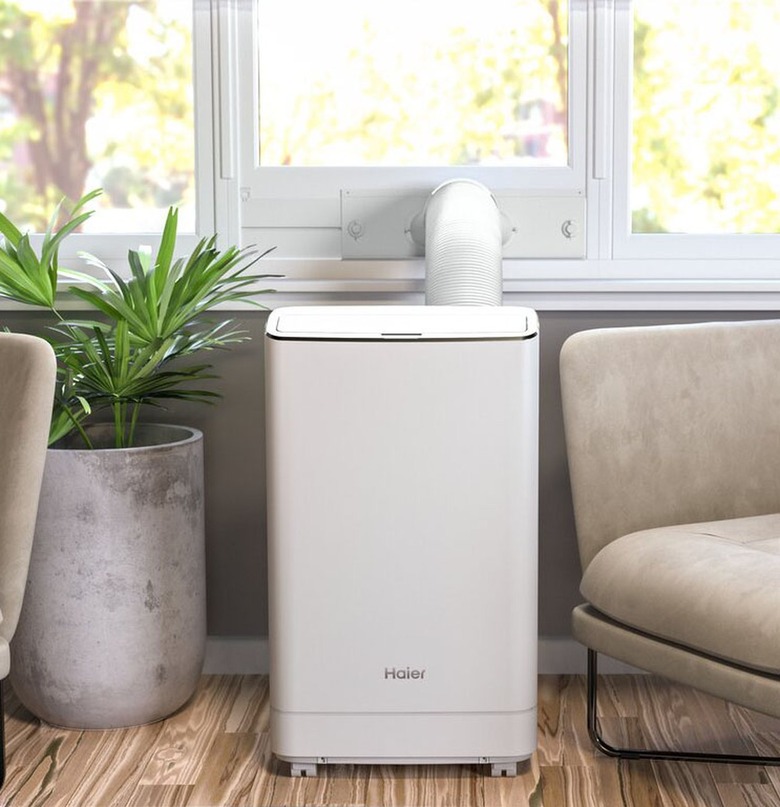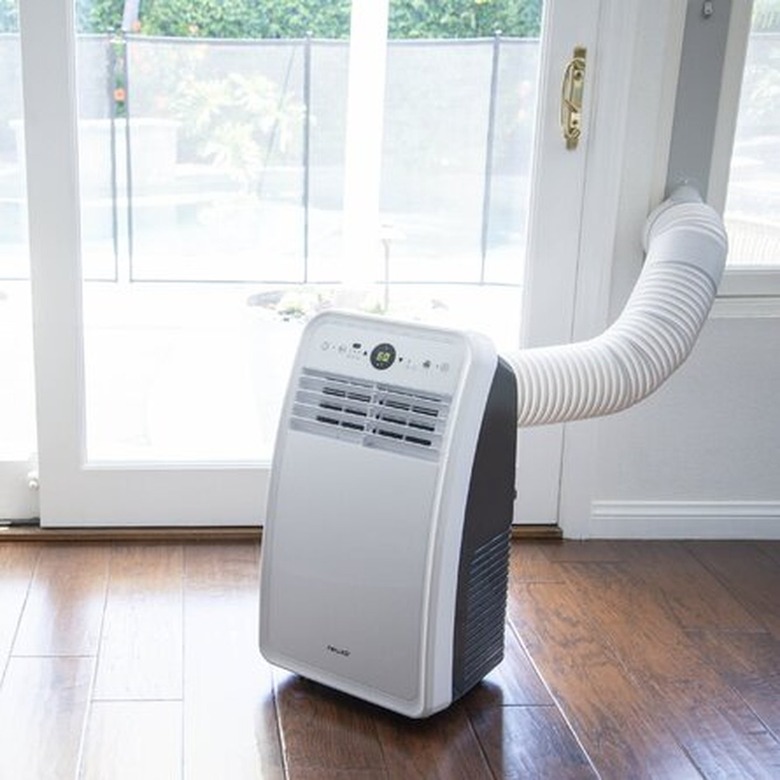How Does A Portable A/C Unit Work? A User's Guide
We may receive a commission on purchases made from links.
In principle, all air conditioners, including portable A/C units, are essentially one-way heat pumps that cool by absorbing heat from an indoor space and releasing it outdoors. They perform this seemingly magical action through some basic science: Vapor becomes hot as it is condensed toward the liquid state and then cools down when it is expanded or evaporated. In fact, drying sweat cools your skin through this exact principle. Water evaporating (expanding) into its gaseous state always becomes cooler. In the case of an air conditioner, this natural principle is made to work on a chemical refrigerant circulating through metal coils in the appliance.
Although you may only be interested in cooling down your home with a portable A/C, it's important to understand how it works in case something goes wrong with your unit (especially since these items aren't exactly cheap to replace).
Tip
A portable air conditioning unit works as a self-contained heat pump that absorbs heat from indoor spaces and vents it to the outdoors through an exhaust hose mounted in a window. Unlike window A/Cs, a portable A/C is mounted on wheels or casters, allowing you to move it to wherever it's needed.
Air Conditioning Basics
Air Conditioning Basics
All air conditioners work thanks to a closed loop of piping that is filled with a flowing refrigerant. This refrigerant is alternately expanded (evaporated) into a low-density gas, which causes its temperature to drop, and then it is compressed into a high-density gas or liquid, which causes its temperature to rise. The cool refrigerant is able to absorb heat from the indoor air, cooling your indoor space, and is then pumped to a different location in the system where it is compressed to release its heat to the outdoors.
Any air conditioner, then, has the same basic parts: metal tubing (coils) that contain the refrigerant chemical, a condenser that compresses the refrigerant, an evaporator that expands the refrigerant, pumps that move the refrigerant through the system, and fans that circulate the air past various coils to either absorb or release heat. There are assorted other components as well, such as thermostats and various valves that allow the equipment to be controlled, but the basics of an air conditioner are fairly simple to understand.
As the refrigerant in the coils passes through the evaporator, it expands into a cooler gas, which allows it to absorb room heat. The refrigerant then moves through a condenser that compresses the gas back toward the liquid state, causing it to grow hot and release its heat. This continuous cycle of the refrigerant expanding and condensing is what allows the appliance to steadily cool the room by absorbing its heat and releasing it into a different location.
With both window air conditioners and central air conditioning, the cooling elements are located on the indoor portion of the equipment, and the heat-releasing elements are located outdoors. This is categorically different from how portable air conditioners work, as both the cooling and heat-releasing elements are found in the same indoor cabinet.
How Portable Air Conditioners Differ from Window Units
How Portable Air Conditioners Differ from Window Units
Although portable A/C units and window air conditioners perform the same functions (i.e. cool you down without having to install central air) there are some notable differences between the two. The biggest difference is in how condensed moisture is handled — or, the water that accrues from the process of cooling down the room.
Because the action of cooling humid air naturally causes air moisture to condense into liquid, portable air conditioners must have some means of handling this condensed moisture. On many newer models, this humidity is blown out through the exhaust hose or channeled away in a drain line, but many models (and almost all older ones) have a basin that must be regularly emptied as it fills up with water that condenses out of the humid air. This is entirely unnecessary with window air conditioners, where moisture simply drips to the ground from the outdoor portion of the appliance's cabinet. However, it's important to note that this drippage can potentially cause stains on your siding.
Types of Portable Air Conditioners
Types of Portable Air Conditioners
There are several types of portable air conditioners. All are simple plug-in appliances in upright cabinets mounted on wheels or casters for easy portability.
Single-Hose Portable Air Conditioners
In a single-hose unit, there is one exhaust hose that vents the warm air produced by the appliance as it absorbs heat from the indoor air circulating through the unit. This hose is usually mounted in a bracket that can fit neatly in almost any type of window.
This single-hose design is easier to install, but it can also create a negative pressure situation since it is blowing air out of the room without replacing it. This negative pressure may draw in hot air through cracks around windows and doors, making a single-hose air conditioner somewhat less efficient than other designs. Single-hose models are often less expensive since they operate with just one circulating fan that serves to both circulate the indoor air and blow the hot, humid air out the exhaust vent hose.
Most portable air conditioners have two modes of action as well as variable-speed settings. In A/C mode, they primarily chill the air, a function that naturally dehumidifies, but they can also be set for use as a pure dehumidifier that removes air moisture without venting hot air to the outdoors. In this mode, it may not even be necessary to connect the vent hose.
Dual-Hose Portable Air Conditioners
Dual-hose portable A/Cs have one vented hose that exhausts the humid, hot air and another hose that draws in fresh air. Dual-hose A/Cs are somewhat more complicated and expensive appliances than single-hose models since they have separate fans — one to draw in outside air and the second hose to circulate room air and exhaust the hot air. Dual-hose units prevent the negative pressure situations that sometimes occur with single-hose A/Cs, but they are a bit more complicated to set up since you must mount two hose vents in a window.
Dual-hose portable A/Cs are slightly more expensive than single-hose models, but they are more efficient.
Ventless Portable Air Conditioners
There are some portable A/Cs that are advertised as ventless designs. This is slightly misleading since these appliances are more properly known as evaporative air coolers (or swamp coolers) rather than air conditioners. This type of appliance is most useful in very dry climates since they operate by an entirely different principle: They put moisture into the air rather than removing it.
This type of evaporative air cooler has a fan that circulates room air past some kind of saturated water wick or pad, and the air picks up the moisture and moves it into the room. The physics is similar to the way a breeze will cool your skin as it evaporates sweat. When water evaporates, the natural result is that the vapor cools.
There is no chemical refrigerant at all in these units, and while evaporative coolers consume much less power than true air conditioners, they are not very practical in humid climates, where the last thing you want is to add more moisture to the air. They also do not have the robust cooling capacity of a true air conditioner.
Reversible Portable Air Conditioners
As is true with newer window A/Cs, there are a few types of portable air conditioners that also have heating functions. The appliance's function can be reversed so it can serve as either a heater or an air conditioner depending on your needs. These are essentially portable versions of the traditional heat pump, in which the appliance can also be set to extract the heat from the outdoor air drawn into the appliance.
These reversible portable heat pumps cost considerably more than A/C-only units, but they can be very useful for sun porches or other areas where the existing central HVAC system is insufficient to supply winter heat or summer cooling.
Basic Maintenance Needs
Basic Maintenance Needs
The basic upkeep of a portable air conditioner is quite similar to the recommended maintenance for a window air conditioner. Portable air conditioners have one maintenance need not found with windows A/Cs: Because they are indoor appliances, the water that is removed from the air must be handled.
The basic maintenance needs for a portable air conditioner are fairly simple:
- Check and empty the water reservoir daily. New models handle water in different ways, but with older models, you'll need to empty a water reservoir manually. Many units have auto-shutoff features that will stop the appliance if the reservoir becomes full, but with others, there is the potential for water to spill over and ruin the flooring. Expect to empty the reservoir more often during periods of humid weather.
- Clean or replace air filters at least monthly. Some models have sensors and control panel displays that will tell you when to replace or clean the filters, but these sensors are not always accurate. Homes with pets may require filter changes more often. Most filters are easily cleaned simply by rinsing them. Let the filter dry completely before reinstalling it. Some models may have multiple filters.
- Keep the cabinet out of direct sunlight to keep the plastic from fading. Clean the cabinet with a damp sponge periodically and keep the outer grilles free of dust and pet hair.
- Empty and thoroughly clean the water reservoir. If the unit sees long periods of inactivity, make sure to get this done to prevent the growth of mold from occurring.
- Store the appliance in a cool, dry place when not in use. During long periods of inactivity, store it in a safe spot, preferably in its box or sealed in a plastic bag.
Tips for Efficient Operation
Tips for Efficient Operation
Portable air conditioners are not very energy-efficient appliances, so it's important to take measures to reduce energy consumption wherever possible.
- Follow the basic maintenance recommendations. Dirty filters make your appliance work harder, so keep them clean.
- Don't run the portable air conditioner constantly. When in cooling mode, it's normal for the appliance's air-circulating fan to run constantly even though the cooling function is starting and stopping according to signals from the thermostat. However, there is no advantage to allowing the fan to run when you are not home or when you will not be using the room for long periods. It's much more energy efficient to turn off the unit entirely or put it on a timer when you don't need direct cooling.
- Keep the appliance well away from furniture and drapes. Room air needs to flow freely through the cabinet, so don't allow anything to block that flow.
- Seal windows and doors. Single-hose portable air conditioners in particular can create negative pressure that can draw in hot outdoor air through almost any crack. Basic weather sealing will make your portable air conditioner work more effectively. Pay particular attention to the vent fitting where the hose exits through the window.
- Clean off the condenser coils at the start of each cooling season. The refrigerant will be most effective if the circulating air can make direct contact with the metal coils, so a yearly cleaning will ensure good operation. Consult your appliance manual for instructions on how to clean the coils.

